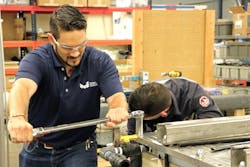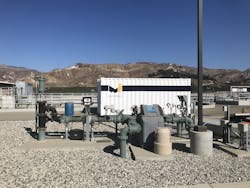About the author:
Grant Page is founder, chairman, president & CEO for Magna Imperio Systems. Page can be reached at [email protected].
Magna Imperio Systems Corp. installed a water-treatment system at the Ventura County Waterworks District 16 Piru Wastewater Treatment Plant.
The installation was part of a two-week pilot program at the plant, which is located in Piru, California, a small community situated about 50 miles northwest of Los Angeles.
Electrochemical Nano Diffusion Pilot Program
For the pilot program, Magna Imperio Systems applied its Electrochemical Nano Diffusion (END) technology, a water treatment system created by the Texas-based water company to provide clean, safe water in a cost effective manner. During the pilot program, the END technology successfully treated approximately 14,000 gallons per day (gpd) of the Piru Wastewater Treatment Plant’s effluent for two weeks during the month of November.
Without this technology in place, the wastewater treatment plant would have had to use other means to rid the location of effluent, such as utilizing trucks to haul away large volumes of brine to an offsite facility so that any remaining discharge would not seep into the surrounding aquifers, a process which is both costly and timely.
The pilot program helped divert discharge to other locations and aided the plant in becoming compliant with the state’s regulations for groundwater recharge, which requires chloride levels to not exceed 100 ppm, and overall total dissolved solids (TDS) levels to be no more than 1,000 mg/L TDS.
“Not only did we bring the plant into compliance, but we successfully achieved 96% water recovery,” said Grant Page, founder and CEO of Magna Imperio Systems. “This is immensely beneficial for Ventura County, as their groundwater basins are severely over drafted, and treating this wastewater treatment plant effluent will allow the county to safely add another 150 acre-feet of water per year to the local groundwater basin. Successfully desalinating wastewater plant effluent and achieving a water recovery this high has never been
done before.”
Global Water Innovations — a California project developer — brought in Magna Imperio Systems to provide new solutions for the wastewater treatment plant, whose chloride levels exceeded the levels mandated by the state.
“The method of discharge that [the Piru Wastewater Treatment Plant] was using [before END technology] was in violation of their permit,” said Dr. Chad Unrau, COO and CTO of Magna Imperio Systems. “What they were looking to do with our system was to get their chloride level back in line, and now that water can be used for aquifer recharge.”
Using END to Desalinate
Another benefit provided by the technology was its ability to desalinate the water it treated.
“Salt is a big problem everywhere, particularly in California,” Dr. Unrau said. “Anything we can do to take that salt out of the water source and reallocate it somewhere else is pretty valuable.”
Dr. Unrau added that for the pilot program, his team at Magna Imperio Systems ensured water recovery would be greater than 95%.
“So, for example, with 100 gallons going in, only 5 gallons would become waste, and that waste we were able to send to an enhanced evaporation pond,” Dr. Unrau said. “There’s not a lot of land available near the plant, so minimizing the size of the pond was important in making that solution effective. Trucking the waste off would be too costly. One thing our technology is really great at is minimizing the costs around brine handling.”
How Electrochemical Nano Diffusion Works
This electrochemical nano diffusion technology uses a proprietary system of membranes, electrodes, and spacers that work in unison to remove ammonia, nitrates, iron, fluoride, silica, and other impurities from a water supply with the additional aim of being efficient and cost effective.
“It really comes down to energy consumption, because it takes a lot of energy to take salt out of water.” Dr. Unrau said. “To lower energy consumption, we minimized the inner membrane spacing. Every component in our stack contributes to electrical resistance, which in turn contributes to energy consumption.
“We also narrowed the flow channels and utilized novel membranes that have low water permeability, which forces the water to stay where we want it to. And then we have low-resistance electrodes. By combining all of these things into our internal stack components, we were able to drive down energy consumption.”
The way each stack is set up also helps with the maintenance of the equipment, while also reducing any buildup caused by minerals over time thanks to a reversal cleaning system. When it does come time to replace a stack, it can easily be removed and sent back to Magna Imperio Systems to be refurbished.
“By shrinking down the entire stack, it’s much easier to handle since it only weighs about 35 pounds, so only one person is needed to swap it out of the system,” he said. “Ultimately, we can refurbish our stacks because we can take them apart, clean up the interior components, and get them back into service, which you can’t do with a traditional osmosis element because those are designed to be used and then thrown away.”
According to Magna Imperio Systems, it can build an entire water-treatment system using this technology in three to four months. Given the success of the pilot program, Ventura County plans to initially install a system to treat up to 280,000 gallons per day.


